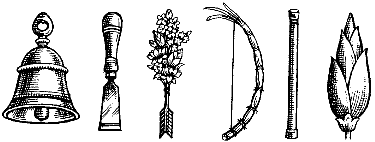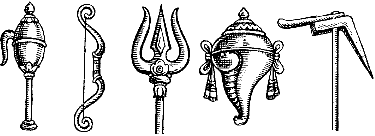
|
||
|
| ||
Murukan Worship through Musical FormsDr. (Mrs) N. JayavidhyaHinduism is classified into six orthodox theistic sects, namely Śaivam, Vaishnavam, Śaktam, Ganapatyam, Kaumaram and Sauryam. In this Kumara or Murukan cult, music has been recognized as one of the orthodox avenues of worship. It has been said that Murukan worship began in the Cankam Age. For this we have the reference of velan veriyatal. That ancient veriyatal evolved into Murukan worship and then it was converted into a form of Agama worship. There are many paths to worship God. But music is the easiest and the most pleasant path to reach Him. music was an important medium of propagation of bhakti. There are two margas in music to attain God. They are jñāna marga and kīrtana marga. Kīrtana marga is easier and is one within the reach of the common man. There are many literary works describing Murukan worship, e.g. Tolkāppiam, Tirumurukāttruppatai, Kuruntogai, Paripātal, Kalitokai, and Cilappatikāram. Besides these works, Arunagiri's Tiruppukal, Vallalar's Teyvamanimālai and Kavi Kunjarabharati's Skanda Purana kirtanas are also sung in praise of Lord Murukan. Also, there are folk traditions which that define Murukan worship in their own style. Not only in literature but also in folk musical forms like cintu, kummi, etc., one may see the forms of Murukan worship. From the 19th century to this day there have been many saint composers and musicians have developed Murukan worship through music. Some notable persons are Annamalai Reddiar, Papanasam Śivan, Kotiswara Iyer, Bharatiyar, Periyasami Tooran, et al. This article explains and expresses how the padavarnam, kīrtana, tillana and kāvati cintu illustrate Murukan worship and its development. The aim of the author in composing musical forms was to share joy with others which they received from the Lord. Further they also wanted to spread the Murukan cult as well. In this paper an attempt has been made to look into all these aspects with special reference to Murukan worship through musical forms. PadavarnaIn our Indian cultural tradition we praise the Lord through music and also express our thoughts through abhināyam. While kirtana seeks to reach God through praise, the padavarnas attain the same goal through love. There are three important divisions in varna: nritta, nritya and abhinaya. For the Pallavi, Anupallavi part nritta and natya is performed. For the Muktayisvara nritta is performed and for the Carana nritta, nritya and abhinaya is performed. Varnas are of two kinds: tana vana and pada varna. Padavarnas also called cauka varnas and ata varnas are the composition heard in dance concerts. The entire composition herein has sahitya. The music is in somewhat slower tempo and is intended to give full scope to convey the bhavas. Because of its affinity to padam, both in point of tempo and the theme of the sahitya, this composition is called padavarna jati are found within some padas. Padavarnas having a grammar of love theme. Yankī-Nāyakī relationship is well brought out in the padavarna. As we know all the padavarnas of a dignified nature, are on the theme of madhura bhakti, including the outward sringara meaning and the inner philosophical meaning. Papanasam Śivan's famous padavarna set in Srirañjani raga and in Aditala, portrayed her feelings of love for Murukan. "Swāmi nānuntan atimai entru ulakamelam ariyumē
Here the nayaki asks him pathetically, "Why have you not come. I can't bear your separation. Please come to me soon." She says that he should give up his anger towards her, if any, and enjoy with her and without delay come to her: "Come to me please. Come and remove my sufferings." And she is asking Lord Murukan to gratify her. This theme is depicted beautifully through the characters of Yankī - Nāyaki, the composer of this padavarna bring out many important truths. KirtanaAccording to the nine kinds of bhakti, kīrtana means songs in praise of God. Pukal in Tamil and kīrtana has the angas pallavi anupallavi and carana. Before the term kīrtana its figured in different musical compositions such as Tēvapani, Tēvaram, Tiruppukal and kīrti tiru akavāl. As it is a sacred musical form, a sahitya is about praising God or begging pardon, etc. Sometime it may be also connected with some puranic incidents. Many kīrtanas are hydrological. The music as well as the rhythm of a kirtana are simple in character. It is a composition belonging to the realm of applied music. The music is used there in only as a vehicle to sing the glories of Lord. Even in swear words the music is used simply as a means to approach God. The motive behind the kirtana is the creation of bhaktirasa or the feeling of devotion. From 16th century onwards there have been many kirtana composers who have composed in praise of Lord Murukan. Composers who have composed songs in praise of Murukan include Kōtisvara Iyer, Papanasam Śivan, Periyasami Tooran, Mutusami Dikshadar, Kavi Kunjarabharathy and others. In the 20th century, Kotīsvara Iyer followed the Kaumara cult or Murukan cult and composed many kritis in praise of Lord Murukan. He composed 72 mela karta kīrtanas in Lord Murukan. These songs are in two volumes known as Kantakānāmutam. In these songs he describes the beauty of Murukan and how to pray and obtain His blessings. Besides Murukan, he add the other supreme is like Śiva, Parvati, Nandi and saints like Patanjali, Sambandar, Nakkeerar, Arunagiri, et al. "Ambikai Aranum Centirumālum ānkalaivāni ampuyanum
He followed the style of musical trinity and composed these songs. He added to it interesting devices such as his kula devata's name and also his forefather's name Kavikuñjara Dāsan as his mudra and also used ragamudras. Through these songs he depicts many philosophical ideas and ways of prayer. (ex) Kanta kānamutapānam - jyoticuvarūpini -ati
The other great persons who have composed Murukan songs are Papanasam Śivan and Periyasami Tooran. Papanasam Śivan attracted people through his music. His kirtanas are full of bhakti and contain the beautiful yati and prastara. He went from one place to another and frequently conducted bhajans and Harikathās. His compositions are set in popular ragas like shanmukha priya, kharaharapriya, todi, etc., including the philosophical meaning. He followed the nine kinds of bhakti and composed more than twenty songs in the ragashanmukhapriya: (Ex) - Saravanabhava ennum - Śanmukhapriya - Adi
Sentilāndavan in kharaharapriya, Kārttikeya Gangeya in todi, Kuvialattal in valaji, Murukanai bhaji maname in jonpori are some of his popular songs. In these songs the author says, always pray to Lord Murukan, if you pray always you will attain mukti. Periyasami Tooran belonged to 20th century. He composed Icai Mani Mañjari, Tamilicaippātalkal, Kīrtanai Amutam, Navamani Icai Mālai, Arul Mani Mālai and served through music. His songs are fully devotional. "Iravanai nōkki natakkum muyarciyil eluntavai ennutaiya kīrtanaikal"3 - Periyacāmi Tooran. Besides Murukan he composed songs to Civan, Cakti, Kannan also. Murukan Murukan - Caveri
These are all Tooran's famous songs. Though he was devoted to all the gods of the Hindu pantheon, yet at heart he was Murukan bhakta. He composed many songs in praise of Palani Murukan. I like one form that gives pleasure, that is "Murukan"- Periyasami Tooran.4 There are many composers and musicians who continue to worship Murukan through music. To this day Tamil musicians compose kirtanas in praise of Lord Murukan. TillanaTillana usually begins with jatis like: "Deem tha Deemta Dheemta
It is one of the liveliest of musical forms. Most of the tillanas are composed in praise of God. It has the angas pallavi anupallavai and carana. Tillanas have only one carana, having four line sahitya with the signature of the composer occuring in the carana. Through these charana sahityas we recognise the language and deity of the song. There are many composers who have composed tillanas in praise of Murukan. Leagued Jayaraman famous tillana in praise of Murukan starts with "Dheem Dheem" set in Revati raga and in Adi tala. Through this line the author expresses their love to Murukan: "Kōla Murukanaikkāna ennik
The other tillana "Dheemta Dheemta" set in Hrindavana Saranga raga and in Adi tala, the author asked Murukan to make his dreams come true, adding, "And besides I don't know any person quite like you. So you should bless me Murukan." "Nānvēntum varantantu arulvāi nī mālmarukā
From above these material we may conclude that tillana is also one of the musical form to pray Murukan or expresses their feelings of love. Kāvati CintuThis type of song is known as kāvati cintu.5 "Tīrāta piniyakattrum kantā - un
Kāvati etuttal ('taking kāvati') is one of the ritualistic functions in praise of Murukan aiming to make our thoughts victorious. These are devotional compositions chiefly by Annamalai Reddiar in honour of Lord Murukan in the 19th century and meant to be sung during a pilgrimage when kāvati is carried on shoulders as an offering. These kāvati cintu describes the beauty of Murukan's templea. Places of Ārupatai Vītu are depicted. He also composed kāvati cintu in the form of Yankī-Nāyaki bhava. ConclusionIn musical terms, Murukan worship began with folk music, developed into Tevaram and Tiruppakal, and eventually evolved into musical forms like padavarnam, varnam, kīrtana, and tillana. From these musical forms Kotisvara Iyer, Peiryasami Tooran, Papanasam Śivan and others composed their kirtanas. Annamalai Reddiar composed kāvati cintu. All these composers developed Murukan worship through music, i.e. singing in praise of Lord Murukan, but their musical forms are different. Murukan songs - Kirtana
Kāvati Cintu
End Notes
Dr. (Mrs) N. Jayavidhya,
Index of research articles on Skanda-Murukan |

